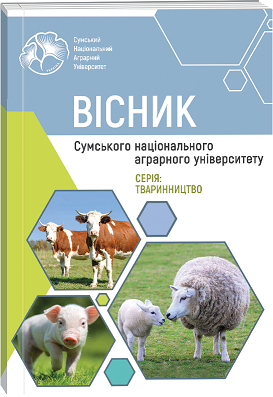EFFICIENCY OF USING NON-PROTEIN NITROGEN PREPARATIONS TO INCREASE THE PRODUCTIVITY OF DAIRY LIVESTOCK
Abstract
Research is conducted in the aspect of using a source of non-protein nitrogen to supplement rations with low-quality feeds during difficult climatic and physiological conditions. The aim of these studies was to confirm the effectiveness of the use of non-protein nitrogen NitroShure to increase the productivity of dairy cattle productivity and reduce the cost of production. To establish the effectiveness of the drug NitroShure, we conducted a study on the basis of agricultural farm "Musiivske", Poltava region. The productive herd of the farm has 500 Holstein cows with an average milk yield of 8,000 kg of milk per head per year. NitroShure technology allows you to control the release of nitrogen in the rumen, which further allows you to synchronize the simultaneous supply of rumen microorganisms with sources of nitrogen and carbohydrates. Balchem's NitroShure is one of the commercially available sources of non-microbial nitrogen in cows' diets: the supplement contains 41% nitrogen and 255% crude protein. NitroShure was added to the diet of 250 cows at the rate of 100 grams per head, which reduced the amount of sunflower meal (SP = 39%) (by 1.2 kg) and add 1 kg of corn silage to increase the starch level to 23% in the diets of animals. After a month of the experiment, the indicators of milk productivity milk productivity increased by an average of 2 liters per head for fat content was 3.8%, protein content - 3.15%. Careful analysis of the structure of manure revealed a significant reduction in the number of long fibers and coarse particles, which indirectly indicates an increase in the efficiency of digestion of dietary fiber, which resulted in increased milk productivity. Due to the recalculation of the ration, the cost savings per ration per day using NitroShure amounted to UAH 5.15, which in terms of livestock per month amounted to UAH 38,625. Profit from the sale of additional milk received amounted to UAH 180,000 per month. Thus, IOFC amounted to UAH 218,625 for the period of use of NitroShure in the experimental group. Therefore, it can be concluded that improving the absorption of nitrogen by the microorganisms of the rumen allows to reduce the level of protein in the diet. The drug increases the breakdown of carbohydrates into volatile fatty acids, which reduces the proportion of energy supplements in the diet. The use of the drug provides an increase in milk yield due to the enrichment of feed with various energy sources. Additional saturation of feed with energy increases milk production and improves its quality, which creates the possibility of additional income (IOFC).
References
2. Beck Tim, Ishler Virginia A. Managing Income Over Feed Costs (Online) https://extension.psu.edu/managing-income-over-feed-costs
3. Briggs, P.K. 1960. Urea as a nitrogen supplement in the utilization of low-quality roughage by Merino sheep. Proc. 8th int. Grass. Congr., p. 579–583.
4. Currier T. A., Bohnert D. W., Falck S. J., Schauer C. S. and Bartle S. J., 2004. Daily and alternate-day supplementation of urea or biuret to ruminants consuming low-quality forage: II. Effects on site of digestion and microbial efficiency in steers, J. Anim. Sci. 2004. 82:1508–1517 http://dx.doi.org/10.2527/2004.8251508x
5. Datasheet Under Construction, 2010. Http://Www.Feedipedia.Org/Node/58
6. Huntington, G.B. 1986. Uptake and transport of nonprotein nitrogen by the ruminant gut. Fed. Proc. 45:2272–2276.
7. Huntington, G.B., Harmon, D.L., Kristensen, N.B., Hanson, K.C. & Spears, J. W. 2006. Effects of a slow release urea source on absorption of ammonia and endogenous production of urea by cattle. Anim. Feed Sci. Technol. 130:225–241. https://doi.org/10.1016/j.anifeedsci.2006.01.012
8. Morris, J.G. 1958. Drought feeding studies with cattle and sheep. I. The use of native grass hay (bush hay) as the basal component of a drought fodder for cattle. Qld J. Agric. Sci., 15: 161–180.
9. Nadeem, M. S., Pasha, T. N., Jabbar, M. A , Javed, K., Khan, M. Z. Naveed S. and Ditta, Y. A., 2014. Effect of of Different Non-Protein Nitrogen (NPN) Sources on Performance of Lactating Nili-Ravi Buffaloes, The Journal of Animal & Plant Sciences, 24(Suppl. 1): 2014, Page: 1-4 ISSN: 1018-7081 https://citeseerx.ist.psu.edu/viewdoc/download?doi=10.1.1.1037.4143&rep=rep1&type=pdf
10. Ortolani, E. I., Mori, C. S., Filho, J. A. R. 2000. Ammonia toxicity from urea in a Brazilian dairy goat flock. Veter. and Human Toxico. 42(2): 87-89. https://pubmed.ncbi.nlm.nih.gov/10750172/
11. Ozgen, H., 1978. Animal Nutrition. Ankara University Printing House, Ankara, Turkey, pp: 60-61.
12. Panday Dinesh, 2010. Urea as A Non-Protein Nitrogen Sources For Ruminants, Alltech Young Scientist Competition, https://fliphtml5.com/rzpg/eelq/basic
13. Ryley, J.W. 1961. Drought feeding studies with cattle. 6. Sorghum silage, with and without urea, as a drought fodder for cattle in late pregnancy and early lactation. Queensland Journal of Agricultural Science 1961 Vol.18 pp.409-424 https://www.cabdirect.org/cabdirect/abstract/19631401518
14. Satter, L.D. and, Roffler, R.R., 1977. Protein Requirement and Non Protein Nitrogen Utilization, Trop Anim Prod 1977 2:3 https://cipav.org.co/TAP/TAP/TAP23/2_3_1.pdf
15. Stanton, T.L. & Whittier, J. 1998. Urea and NPN for Cattle and Sheep Colorado state university Extantion, Fact Sheet №1.608, Livestock Series|Management https://extension.colostate.edu/docs/pubs/livestk/01608.pdf
16. Tadele Yilkal, Amha Negassie, 2015, Use of Different Non Protein Nitrogen Sources in Ruminant Nutrition: A review Advances in Life Science and Technology www.iiste.org ISSN 2224-7181 (Paper) ISSN 2225-062X (Online) Vol.29, https://core.ac.uk/download/pdf/234687103.pdf

 ISSN
ISSN  ISSN
ISSN 



